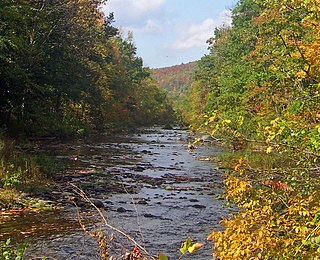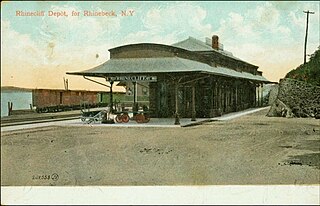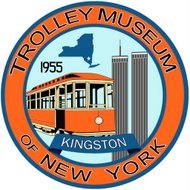Related Research Articles

For the purposes of this article, the Jersey City area extends North to Edgewater, South to Bayonne and includes Kearny Junction and Harrison but not Newark. Many routes east of Newark are listed here.

NY Waterway, or New York Waterway, is a private transportation company running ferry and bus service in the Port of New York and New Jersey and in the Hudson Valley. The company utilizes public-private partnership with agencies such as the Port Authority of New York and New Jersey, New Jersey Transit, New York City Department of Transportation, and Metropolitan Transportation Authority to provide service and maintain docking facilities.
The Ulster and Delaware Railroad (U&D) was a railroad located in the state of New York. It was often advertised as "The Only All-Rail Route to the Catskill Mountains." At its greatest extent, the U&D extended 107 miles (172 km) from Kingston Point on the Hudson River through the Catskill Mountains to its western terminus at Oneonta, passing through the counties of Ulster, Delaware, Schoharie and Otsego.

The Delaware and Hudson Canal was the first venture of the Delaware and Hudson Canal Company, which would later build the Delaware and Hudson Railway. Between 1828 and 1899, the canal's barges carried anthracite coal from the mines of northeastern Pennsylvania to the Hudson River and thence to market in New York City.

Rondout Creek is a 63.3-mile-long (101.9 km) tributary of the Hudson River in Ulster and Sullivan counties, New York, United States. It rises on Rocky Mountain in the eastern Catskills, flows south into Rondout Reservoir, part of New York City's water supply network, then into the valley between the Catskills and the Shawangunk Ridge, where it goes over High Falls and finally out to the Hudson at Kingston, receiving along the way the Wallkill River.

The Pennsylvania Railroad Station was the intermodal passenger terminal for the Pennsylvania Railroad's (PRR) vast holdings on the Hudson River and Upper New York Bay in Jersey City, New Jersey. By the 1920s the station was called Exchange Place. The rail terminal and its ferry slips were the main New York City station for the railroad until the opening in 1910 of New York Pennsylvania Station, made possible by the construction of the North River Tunnels. It was one of the busiest stations in the world for much of the 19th century.

The Rhinebeck and Connecticut Railroad (R&C) was a railroad in Dutchess and Columbia counties in New York, United States. Its line ran 35 miles (56 km) east from the Hudson River at Rhinecliff to Boston Corners. It was chartered in 1870 to connect the Connecticut Western Railroad with the Hudson River to transport coal mined in Pennsylvania. Construction began in 1871, with the line opening in stages from 1873 to 1875. The railroad went bankrupt in 1881; it was purchased the next year by Connecticut Western successor Hartford and Connecticut Western Railroad (H&CW).

Rhinecliff station is an Amtrak intercity rail station located in the Rhinecliff hamlet of Rhinebeck, New York, United States. The station has one low-level island platform, with a wheelchair lift for accessibility. It is served by the Adirondack, Berkshire Flyer, Empire Service, Ethan Allen Express, Lake Shore Limited, and Maple Leaf.

The Central Railroad of New Jersey Terminal, also known as Communipaw Terminal and Jersey City Terminal, was the Central Railroad of New Jersey's waterfront passenger terminal in Jersey City, New Jersey. The terminal was built in 1889, replacing an earlier one that had been in use since 1864. It operated until April 30, 1967.

The Trolley Museum of New York is a non-profit organization located at 89 East Strand Street in Kingston, New York. The museum is open to the public on a seasonal schedule, but volunteer activities relating to the preservation of historic transit are year-round.

The Newburgh–Beacon Ferry is a ferry service crossing the Hudson River that connects Newburgh with Beacon in the U.S. state of New York. It carries passengers between the two cities during rush hour, primarily transporting commuters from the west side of the river at Newburgh to the commuter train station on the east side at Beacon where they can catch Metro North Hudson Line service to Grand Central Terminal and other points in New York City.

Rondout, is situated in Ulster County, New York, on the Hudson River at the mouth of Rondout Creek. Originally a maritime village, the arrival of the Delaware and Hudson Canal helped create a city that dwarfed nearby Kingston. Rondout became the third largest port on the Hudson River. Rondout merged with Kingston in 1872. It now includes the Rondout–West Strand Historic District.
Rhinecliff is a hamlet and census-designated place (CDP) located along the Hudson River in the town of Rhinebeck in northern Dutchess County, New York, United States. As of the 2010 census, the population of Rhinecliff was 425.

The Ulster & Delaware Railroad Historical Society is a chapter of the National Railway Historical Society (NRHS). It focuses on the history of the railroads and related social, economic, and cultural institutions of the Catskill and Hudson Valley regions. That history, which began with the charter of the Catskill & Ithaca Railroad in 1828, encompasses numerous proposed and built railroads and trolley lines within Ulster, Delaware, Greene, Schoharie, Albany and Otsego counties.

The Hudson River Maritime Museum is a maritime museum dedicated to the Hudson River.

Weehawken Terminal was the waterfront intermodal terminal on the North River in Weehawken, New Jersey for the New York Central Railroad's West Shore Railroad division, whose route traveled along the west shore of the Hudson River. It opened in 1884 and closed in 1959. The complex contained five ferry slips, sixteen passenger train tracks, car float facilities, and extensive yards. The facility was also used by the New York, Ontario and Western Railway. The terminal was one of five passenger railroad terminals that lined the Hudson Waterfront during the 19th and 20th centuries; the others were located at Hoboken, Pavonia, Exchange Place and Communipaw, with Hoboken being the only one still in use.

M/V Rip Van Winkle is a Hudson River tour boat based in Kingston, New York. She was built for use in the oil industry in 1980, but has served as a passenger vessel in New York State, and as a ferry for the US Navy.

Kingston is the only city in, and the county seat of, Ulster County, New York, United States. It is 91 miles (146 km) north of New York City and 59 miles (95 km) south of Albany. The city's metropolitan area is grouped with the New York metropolitan area around Manhattan by the United States Census Bureau. The population was 24,069 at the 2020 United States Census.

The Chambers Street Ferry Terminal was the Erie Railroad's main ferry slip on Manhattan and the point of departure and embarkation for passengers in New York City. The terminal was one of several operated by ferry companies and railroads that lined the western shore of Manhattan during the 19th and 20th centuries. The Pavonia Ferry operated for over 100 years from the terminal, which was demolished about three years after the Erie Railroad stopped its ferry service to Chambers Street in December, 1958.

Santa Claus was a sidewheel passenger-and-freight steamboat built in 1845 for service on the Hudson River between Wilbur, New York, and New York City. In her first few years of operation, Santa Claus saw service on a number of different Hudson River routes, most notably between Albany and New York City. She was also employed from time to time as an excursion steamer. A highlight of her career occurred in 1852, when she had the honor of conveying the remains of American statesman Henry Clay from New York City to Albany en route to their final resting place.
References
- ↑ Ringwald, Donald C. (January 8, 1957). "History of the Kingston–Rhinecliff Ferry". The Kingston Daily Freeman. pp. 10, 11, 12 – via Newspapers.com.